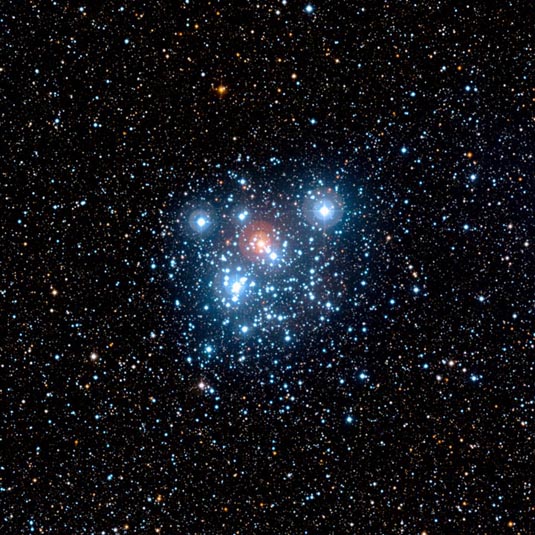
Description: Open Star Cluster
Position (J2000): RA 12hr 53m 13.17s Dec -60° 28' 4.66"
Constellation: Crux
Distance: 6500 light years
Visual Magnitude: 4.2
Field of view: 20.35 x 20.35 arcminutes
Orientation: North is 0.0° left of vertical
Image Credit: ESO
Release date: October 29, 2009
Related Images: Wide-field view ESO Close-up Hubble Close-up
ABOUT THIS IMAGE:
This image of the well-known NGC 4755 cluster or Jewel Box was taken with the Wide Field Imager (WFI) on the MPG/ESO 2.2-meter telescope at ESO's La Silla Observatory. It highlights the cluster and its rich surroundings in all their multicolored glory. The field of view is 20 arcminutes across. The picture is based on images obtained through B, V and I filters.
The Jewel Box cluster is regarded as one of the finest objects in the southern sky. It is visible with the naked eye and can be easily located using the star Beta Crucis as a guide, and appears as a fourth magnitude object. The Jewel Box cluster is impressive when viewed with binoculars or a small or large telescope. It was given its nickname by the English astronomer John Herschel in the 1830s because the striking color contrasts of its pale blue and orange stars seen through a telescope reminded Herschel of a piece of exotic jewelry The three brightest members of the cluster lie in a straight line and are known as the 'traffic lights' due to their varying colors.
Open clusters such as NGC 4755 typically contain anything from a few to thousands of stars that are loosely bound together by gravity. Because the stars all formed together from the same cloud of gas and dust their ages and chemical makeup are similar, which makes them ideal laboratories for studying how stars evolve.
From Wikipedia:
The Jewel Box, Kappa Crucis Cluster, NGC 4755, is an open cluster in the constellation Crux, and was originally discovered by Nicolas Louis de Lacaille during 1751-1752. This famous cluster was later named the Jewel Box by Sir John Herschel when he described its telescopic appearance as "a casket of variously colored precious stones." It is easily found with the naked eye as a hazy star some 1.0° southeast of the first-magnitude star Beta Crucis, and was given its name by its original Bayer star designation of Kappa Crucis. Since known as a star cluster, the second brightest cluster star, placed within the main A-shape, became known as Kappa Crucis. This is a blue supergiant of spectral type: B3Iae, shining at the apparent visual magnitude of 5.94V.
The
Jewel Box is one of the youngest known open clusters, with an estimated
age of 14 million years. It has a total integrated magnitude of 4.2, is
located 6,440 light years from Earth, and contains around 100 stars. The
mean radial velocity of the Jewel Box cluster is -21 kilometers per second
(-13 mi/s). Calculating its distance is difficult due to the proximity
of the Coalsack Nebula, which obscures some of its light.